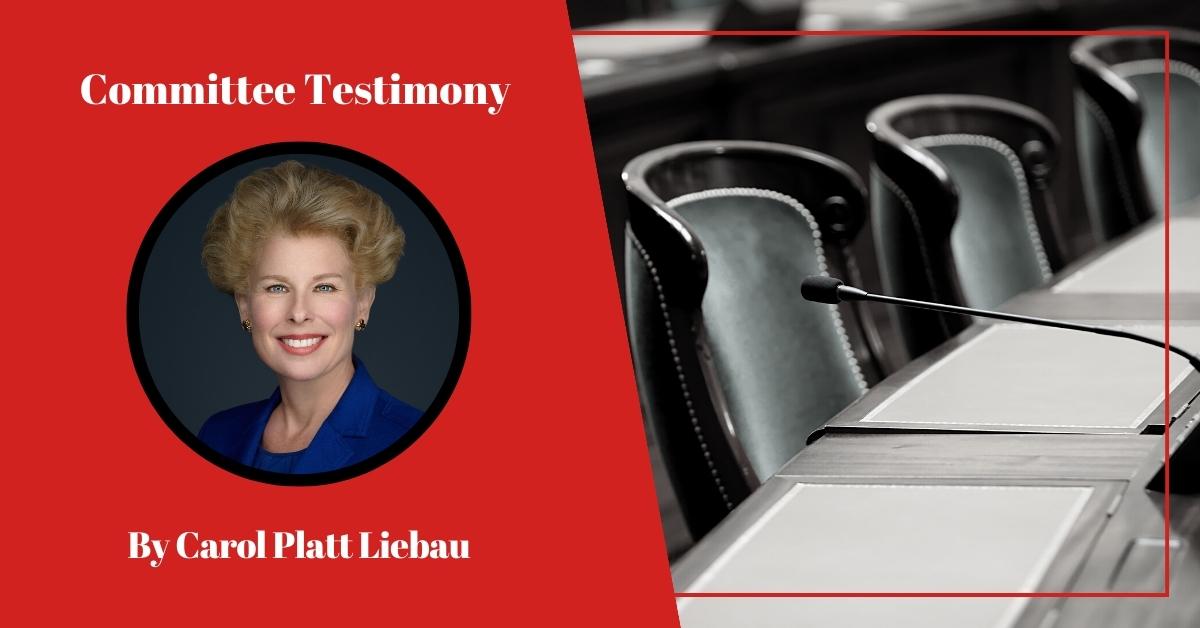February 3, 2023
Good morning.
Thank you for the opportunity to testify before the Appropriations and Education Committees regarding H.B. 5003. My name is Carol Platt Liebau and I am the President of Yankee Institute, a policy organization dedicated to empowering Connecticut’s people to forge a brighter future for themselves and their families.
Yankee Institute appreciates both Committees’ attention to the important matter of education funding. As you know, Connecticut has the second highest per pupil spending among states at $21,346 —14 percent more than Massachusetts and second only to New York.
Connecticut spends more than 20 percent of the General Fund revenue on K-12, with about $2 billion in grants to districts, $1.5 billion to cover pensions, and another $1 billion for myriad initiatives, the largest being magnet schools, charter schools, and vocational agriculture programs.
About 33,000 students are in magnet schools, and another 9,000 are in charter schools. A smaller number of students are enrolled in other districts under Open Choice arrangements. So the proposed legislation will have an enormous impact.
As Yankee Institute has noted before, funding charter schools differently from other public schools harms the children who attend public charter schools, their families, and the hardworking educators who staff them. We commend the Committees for considering a bill that would allow charter and magnet schools to be funded as part of the general Education Cost-Sharing formula.
Yet while H.B. 5003 is an important start, it does not even begin to address the greatest educational inequity between affluent and disadvantaged families in Connecticut: the former enjoy complete freedom to choose any school they deem best for their children’s unique needs — whether private or government schools. The latter have no such choice.
By continuing to restrict its attention only to government schools — whether public, charter, or magnet — the legislature continues to fund a system, rather than a student. We can do better, and we must. A family’s ability to choose the school they believe will offer their children the best education should not be a luxury available only to the rich.
Innovative educational reform is particularly vital in the wake of the school closings that occurred during the pandemic, which had a devastating impact on student achievement. English, math, and science scores all fell from 2021 to 2022 after consecutive years of growth since 2016 — in fact, student performance in every subject tested is down.
And that’s not all. The rate of chronic absenteeism increased by 13 percent between 2019 and 2022, physical fitness dropped 7 percent, and postsecondary readiness and on-track to high school graduation also declined.
Most disturbing, the declines aren’t equally distributed. State data indicates that students in larger, urban school districts have been more adversely impacted by pandemic learning losses than their counterparts in suburban, wealthy districts, exacerbating the existing achievement gap between suburban and urban districts.[1]
Clearly, it is a time for bold, courageous thinking. Parent choice in education has been shown to improve high school graduation rates;[2] significantly increase the likelihood both of college enrollment and earning a bachelor’s degree among low-income students from low-income schools;[3] and even improve outcomes in public schools.[4] Ensuring parents of all backgrounds and incomes have equal access to educational choice could also do much to alleviate underrepresentation of some students of color in Honors and Gifted & Talented or AP programs;[5] their families choose schools where such programs will be made available to them. Indeed, of 10 studies examining the impact on racial segregation of parent choice programs in education, nine of them found that such programs move children into less segregated schools; one found no impact.[6]
H.B. 5003 begins a much-needed process of reform for Connecticut’s students, reducing funding inequities between regular public schools, on the one hand, and charter and magnet schools on the other. We urge the legislators concerned about equity across Connecticut to be mindful of the fact that true commitment to that principle requires every child and family to enjoy a right the current system reserves for the rich: the ability to choose.
Thank you.
REFERENCES
- Fenster, Students in wealthy CT schools bounced back better after the pandemic,” CTInsider, August 26, 2022, https://www.ctinsider.com/news/article/Students-in-wealthy-CT-schools-bounced-back-17398120.php
- Wolfe et al, Evaluation of the DC Opportunity Scholarship Program: Final Report (2010), https://www.researchgate.net/publication/234756567_Evaluation_of_the_DC_Opportunity_Scholarship_Program_Final_Report_NCEE_2010-4018.
- Chingos, Monarrez & Kuehn, The Effects of the Florida Credit Scholarship Program on College Enrollment and Graduation (2019), https://www.urban.org/research/publication/effects-florida-tax-credit-scholarship-program-college-enrollment-and-graduation
- Egalite & Wolf, A Review of the Empirical Research on Private School Choice (2016), https://www.tandfonline.com/doi/full/10.1080/0161956X.2016.1207436
- Camara Stokes Hudson (CT Voices for Children), The Black-White Education Gap in Connecticut: Indicators of Quality in Access and Outcomes, https://ctvoices.org/wp-content/uploads/2018/01/New-Edits-NG-The-Black-White-Education-Gap-In-Connecticut-Indicators-of-Inequality-in-Access-and-Outcomes-Final-Copy-1.pdf
- Forster, A Win-Win Solution: The Empirical Evidence on School Choice (2016), http://www.edchoice.org/wp-content/uploads/2016/05/A-Win-Win-Solution-The-Empirical-Evidence-on-School-Choice.pdf
[1] Fenster, Students in wealthy CT schools bounced back better after the pandemic,” CTInsider, August 26, 2022, https://www.ctinsider.com/news/article/Students-in-wealthy-CT-schools-bounced-back-17398120.php
[2] Wolfe et al, Evaluation of the DC Opportunity Scholarship Program: Final Report (2010), https://www.researchgate.net/publication/234756567_Evaluation_of_the_DC_Opportunity_Scholarship_Program_Final_Report_NCEE_2010-4018.
[3] Chingos, Monarrez & Kuehn, The Effects of the Florida Credit Scholarship Program on College Enrollment and Graduation (2019), https://www.urban.org/research/publication/effects-florida-tax-credit-scholarship-program-college-enrollment-and-graduation
[4] Egalite & Wolf, A Review of the Empirical Research on Private School Choice (2016),https://www.tandfonline.com/doi/full/10.1080/0161956X.2016.1207436
[5] Camara Stokes Hudson (CT Voices for Children), The Black-White Education Gap in Connecticut: Indicators of Quality in Access and Outcomes, https://ctvoices.org/wp-content/uploads/2018/01/New-Edits-NG-The-Black-White-Education-Gap-In-Connecticut-Indicators-of-Inequality-in-Access-and-Outcomes-Final-Copy-1.pdf
[6] Forster, A Win-Win Solution: The Empirical Evidence on School Choice (2016), http://www.edchoice.org/wp-content/uploads/2016/05/A-Win-Win-Solution-The-Empirical-Evidence-on-School-Choice.pdf

